Nuclear Power: Could a New Atomic Age Solve Climate Change?
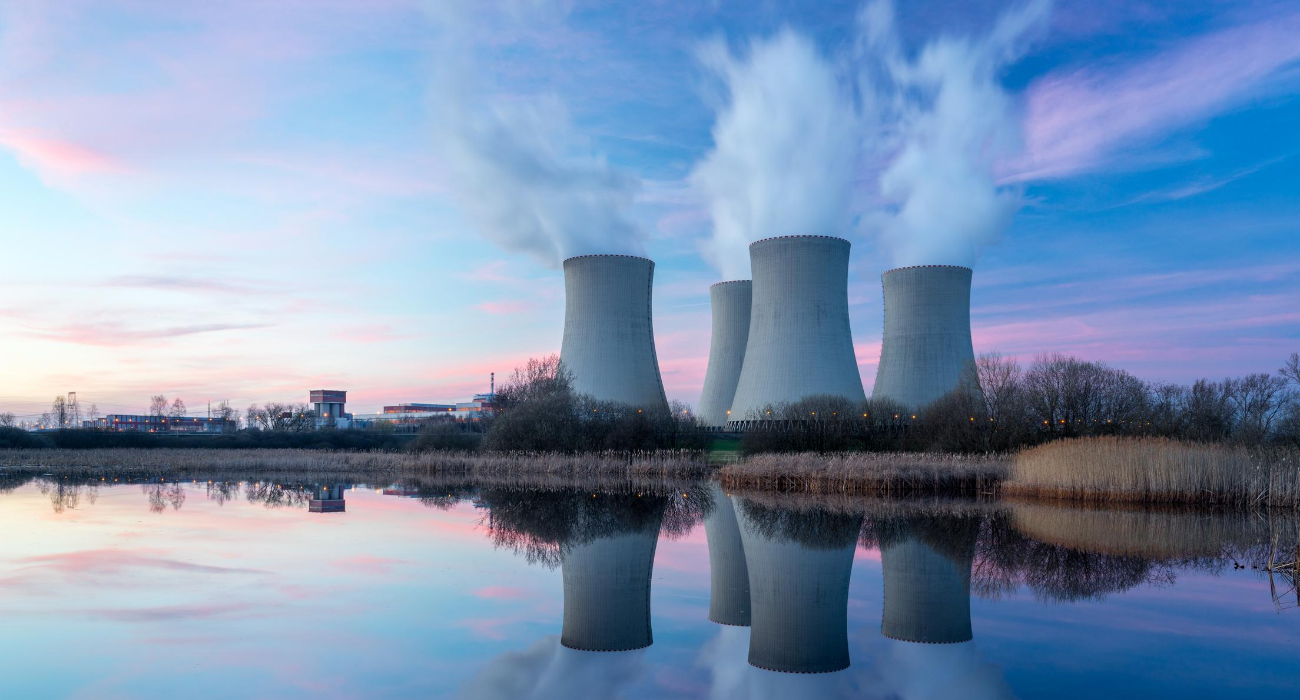
The far left and right in the United States have long presented the American people with a false choice: ignore climate change, or radically disrupt virtually every part of America’s economy and society to fight it. Neither of these approaches makes sense.
The right’s relentless and indefensible climate denial contributes to the already snowballing costs that fossil fuels impose on our economy and environment. In October 2019, The Brookings Institution’s Hamilton Project and the Stanford Institute for Economic Policy Research published a report on climate change which found that not only would a global temperature increase as large as 4°C be accompanied by a two percent GDP decrease, but that “the bottom fifth of counties [in the United States] ranked by economic vitality would experience the largest [economic] damages.”
These conclusions build on previous, more comprehensive studies, such as the Fourth National Climate Assessment—published in 2018 and representing the consensus views of 13 different government agencies—which stated that “climate change creates new risks and exacerbates existing vulnerabilities in communities across the United States, presenting growing challenges to human health and safety, quality of life, and the rate of economic growth.”
On the other hand, implementing many of the provisions in the far left’s Green New Deal could turn out to be more disruptive than its advocates suggest. If done hastily, it could be bad for both the economy and the environment given the plethora of issues still facing renewables, namely their intermittency, low storage capabilities, large-scale land requirements, and reliance on rare earth minerals.
That’s why it’s time for an old energy innovation to become new again in America. As this New Center paper explains, an expansion of next-generation nuclear power may provide the best and most realistic path for America to protect our environment, expand our use of low-carbon energy, and sustain our economy in the years ahead.
What Happened to the Atomic Age?
“Nuclear energy is incomparably greater than the molecular energy which we use today… What is lacking is the match to set the bonfire alight.” —Winston Churchill, 1931
Writing for Strand Magazine in 1931, British Prime Minister Winston Churchill predicted the revolutionary nature of nuclear energy while its development was still in infancy. Fourteen years later, the United States dropped atomic bombs on the Japanese cities of Hiroshima and Nagasaki in 1945 during World War II, leading to a quick Japanese surrender and revealing to the world the destructive power of nuclear energy.
But it also led to the advent of the Atomic Age, during which public interest and policy initiatives spurred the rapid innovation and deployment of nuclear as a source of energy. An analysis from Management Information Services, Inc. of federal expenditures for energy development from 1950 to 2016 shows that “prior to 1976, the primary focus of federal R&D funding was nuclear energy, with an emphasis specifically on research on commercial applications of light water reactors and development of breeder reactors.” This targeted R&D funding, as well as changes to the Atomic Energy Act permitting civilian use, allowed for the further development and deployment of nuclear power over three decades. Data from the International Atomic Energy Agency (IAEA) shows that by 1960, there were 17 nuclear power reactors operating within four countries; by 1970, there were 90 reactors in 15 countries; and by 1980, there were 253 plants in 22 countries, motivated in part by the oil crisis of the 1970s. Nuclear was expanding rapidly around the world, but this growth would soon come to a grinding halt.
For one, building nuclear power plants became increasingly expensive. A nuclear plant that cost between around $600/kW and $900/kW (meaning one dollar for every kilowatt of capacity) in the late 1960s ended up costing between around $1,800/kW to $2,500/kW in the early 1970s. Second, there were growing questions and uncertainties over how to manage radioactive nuclear waste. Third, and most importantly, public perception and support for nuclear power plummeted following the nuclear plant accident at Three Mile Island (1979) in Pennsylvania and the Chernobyl meltdown in the former Soviet Union (1986).
The narrative around nuclear energy changed from that of unbridled promise in the 1950s. Yet, there is no denying that many of the benefits that made nuclear so popular to begin with remain. The question for industry experts and policymakers is how to bring about a new age of nuclear development by harnessing nuclear’s benefits while tackling the roadblocks to its advancement.
The Benefits of Nuclear Energy
High Capacity Factor
According to the No Labels Ultimate Guide to the 2020 Election, “Every electric utility in America has one mandate above all: always keep the lights on. To do it, they need something called ‘baseload’ power, which means power that will always be there when they need it, like for hot days when energy usage spikes because everyone is blasting their air conditioner. The best measurement for an energy source’s ability to meet this standard is capacity factor, which measures how long an energy source can deliver maximum power over a given period.”
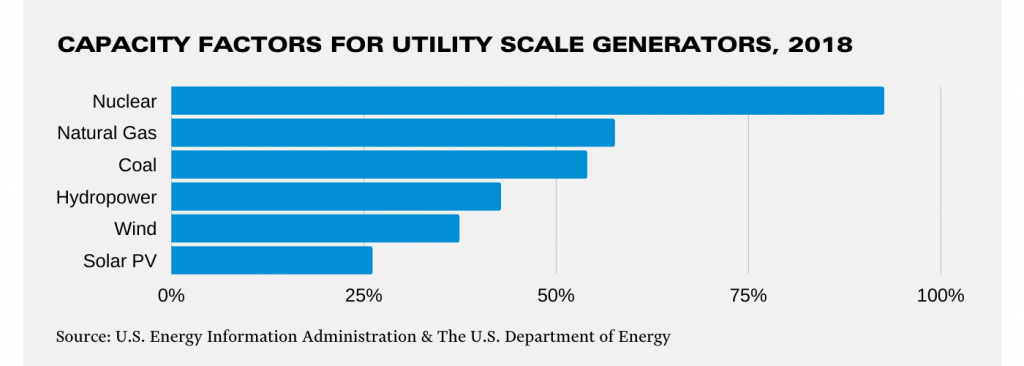
In 1975, the capacity factor of the average nuclear plant was at about 55.9%; by 1990, it had grown to 66%, and only five years later it reached 77%. At the turn of the 21st century, nuclear plants in the U.S. reached a capacity factor plateau point, hovering at an average of 90% since then. 2018 data from the U.S. Department of Energy’s Office of Nuclear Energy shows that despite this plateau, nuclear energy still far outpaces natural gas, coal, hydropower, wind, and solar PV in capacity factor, producing maximum power 92.6% of the time throughout the year.
| The Limitations of Renewables: Why Are Their Capacity Factors So Low? |
| Compared to nuclear, wind and solar PV have lower capacity factors, partly because they are intermittent or variable energy sources reliant on wind and the sun, respectively. While northeastern states such as New Jersey and Massachusetts have the lowest capacity factors for their solar energy, states like Arizona, Utah, and California with greater direct normal solar irradiance rank among the highest. As for wind, although there have been improvements to wind farms and wind turbines—such as taller turbines and longer blades—varied wind conditions can make energy derived from wind very unpredictable. An example of this was the “Wind Drought of 2015,” during which the United States suffered record-low windiness not experienced since 1979. That year, U.S. wind generation grew by only 5.1%, the smallest annual increase since 1999. |
High Electricity Generation
In 2019, nuclear energy contributed 20% of total U.S. electricity generation behind natural gas (38%) and coal (23%). After the first nuclear generating plant opened in the U.S. in 1950, nuclear energy grew in the coming decades to account for a significant share of U.S. electrical output. However, the U.S. Energy Information Administration’s Annual Energy Outlook for 2019 projects that nuclear’s share of electricity generation will decrease to 12% by the year 2050 due to the planned retirement of nuclear plants, while electricity generation from natural gas and renewables will increase.
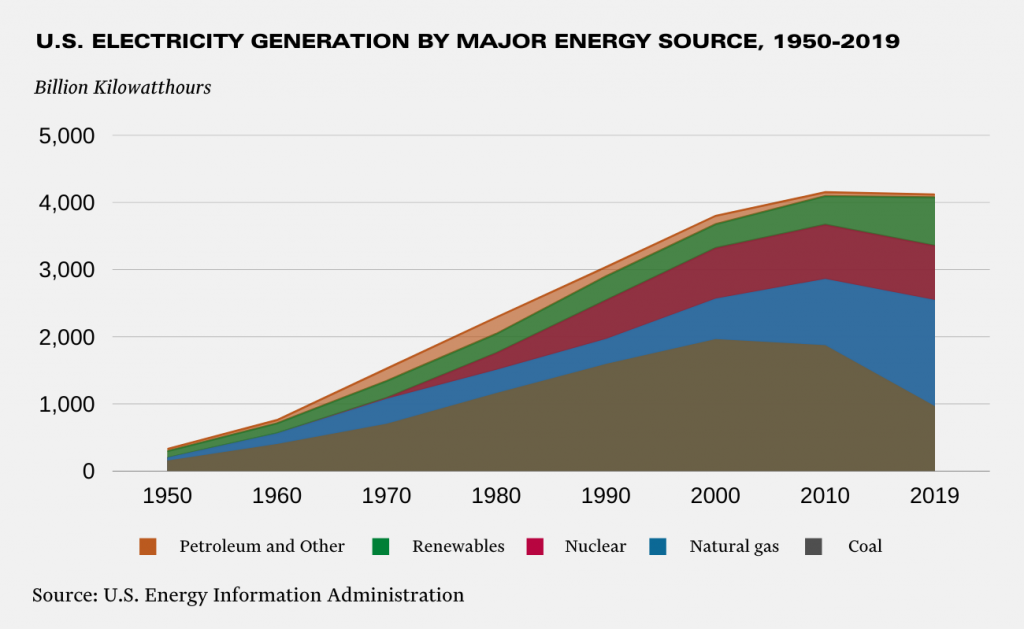
Role in Emission Reductions
The nuclear fission process involves splitting uranium atoms to produce heat and steam which spins a turbine connected to a generator, therefore creating electricity. The fission process itself does not produce greenhouse gases, which is why nuclear energy is touted as an emissions-free source of energy. However, it is important to take into consideration all of the stages of a nuclear cycle, as some of them do in fact produce emissions. According to The Conversation— an independent network of global newsrooms—these include “uranium mining, uranium milling, conversion of uranium ore to uranium hexafluoride, uranium enrichment, fuel fabrication, reactor construction, reactor decommissioning, fuel reprocessing, nuclear waste disposal, mine site rehabilitation, and transport throughout all stages.”
A more holistic analysis of energy source emissions is referred to as a lifecycle greenhouse gas emissions assessment, which the Intergovernmental Panel on Climate Change (IPCC) undertook in its “Special Report on Renewable Energy Sources and Climate Change Mitigation.” The report compared the lifecycle greenhouse gas emissions of both renewable resources and nonrenewable resources and found that even the “maximum” estimates for nuclear energy life cycle emissions are still much less than the estimated greenhouse gases produced by fossil fuels like natural gas, oil, and coal. And when it comes to renewables, wind and solar power both have very similar median estimates to nuclear energy for median life cycle greenhouse gas emissions.
Less Intensive Land Use
As global energy demands rise, greater swaths of land will be devoted to various electricity sources to meet these needs, with some occupying more area than others. In a study conducted by Strata Policy, solar and wind energy were found to be much more land-intensive than coal, natural gas, and nuclear energy. Nuclear energy turned out to be the least land-intensive out of the direct carbon-free emission energy sources and hydropower was the most land-intensive energy source.
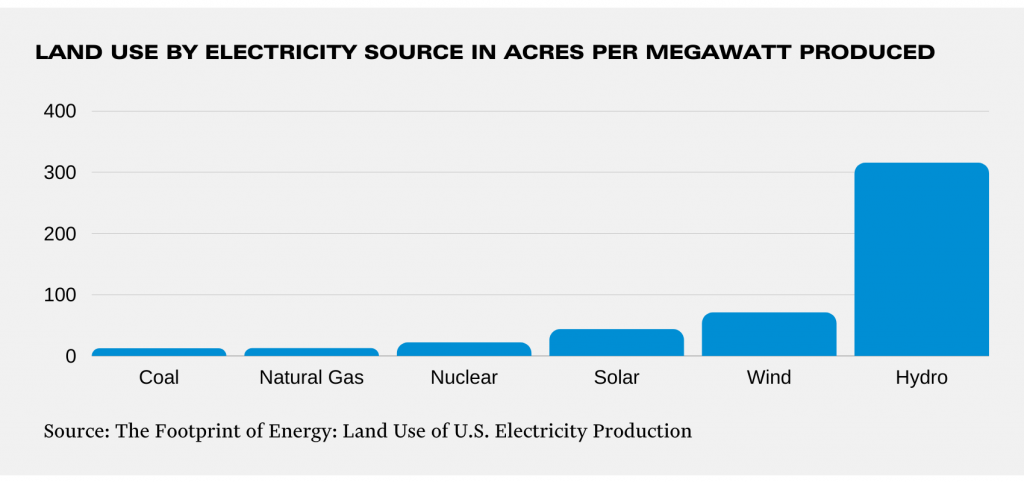
The Problems with Nuclear Energy
Market Competition and Subsidies for Competing Energy Sources
According to the U.S. Energy Information Administration, in FY2016, total direct federal financial interventions and subsidies in energy amounted to about $15 billion. Nuclear energy only accounted for about two percent of these subsidies, while renewables occupied a 45% share.
| Looking Back: Historical Trends in Government Energy Subsidies |
| Although it may seem like renewable energy sources are receiving preferential treatment from the federal government, for a long time fossil fuels dominated federal subsidy and support spending. In fact, according to Management Information Services, Inc., between 1950 and 2016, oil and gas received 54% of all federal spending, while wind, solar, and geothermal only accounted for 17% of spending. During this time period, tax concessions were the largest type of incentive, accounting for 47% of all incentives. Oil and gas received 70% of them. |
Amidst renewables occupying a larger and larger share of total federal energy subsidies, there is a question of whether these subsidies still serve their intended purpose. Several studies, including a comprehensive energy source cost analysis conducted by financial advisory firm Lazard, have concluded that renewables, sans subsidies, can be cost-competitive and even less expensive than traditional energy sources such as nuclear.
But a roadblock to further adoption of both nuclear and renewable energy is the advent of increasingly produced cheap natural gas. The Energy Information Administration predicts that average prices for natural gas will decline by nine percent in 2020. If natural gas prices continue to plummet, the EIA predicts that total national nuclear capacity will fall to 55 GW by 2050 from 99 GW today. Even if natural gas prices end up being higher, nuclear capacity will still fall by 2050, but only down to 83 GW.
Out of four potential cases explored by the EIA that could affect nuclear capacity, only two resulted in increased versus decreased capacity: (1) a situation where natural gas prices are higher and nuclear operating costs are low; and (2) the implementation of a carbon tax.
Public Opinion
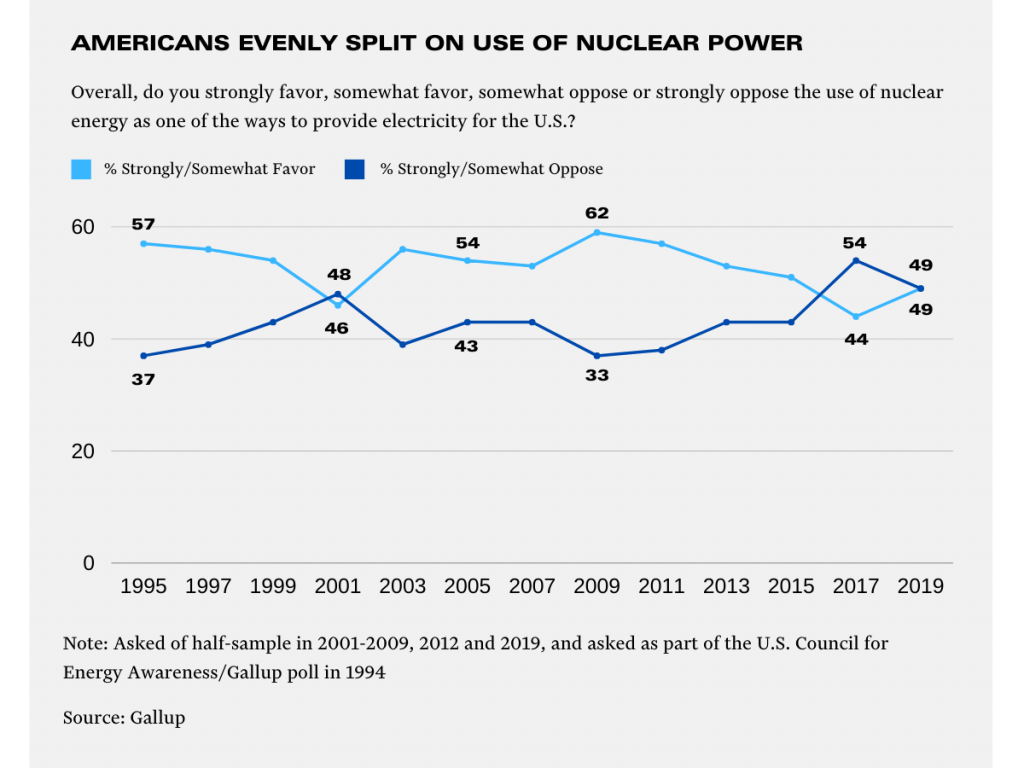
Americans are directionally in favor of an expansion of clean energy sources. According to polling from the Green Advocacy Project, 65% of all voters agree with the statement “in the future, we should produce electricity using 100% clean energy sources such as solar and wind, nuclear, and carbon recapture from fossil fuels,” versus 21% believing that this endeavor would be “costly and unnecessary.” While Americans have warmed up to renewable energy over time, nuclear energy struggled to capture strong support in recent years. For example, results from Gallup’s 2019 annual Environmental Poll show that the American public is split on nuclear energy, with 49% in favor of its use and 49% opposed. This is a 13% decline from a high of 62% support just nine years earlier.
| Nuclear Safety: What is the Real Story? |
| High profile disasters at Chernobyl and Fukushima have led to the public perception that nuclear energy is the most dangerous energy source. However, according to an analysis published by Markandya and Wilkinson in The Lancet in 2007, nuclear energy is responsible for fewer short-term deaths than brown coal, coal, oil, biomass, and gas. This, however, does not account for later deaths brought on by radiation exposure and psychological stress. Researchers at Our World in Data note that according to a wide range of published estimates, deaths resulting from the Chernobyl and Fukushima disasters spanned between thousands of deaths to tens of thousands of deaths, at least. Still, this is “far fewer than the millions who die every year from impacts of other conventional energy sources.” Next generation nuclear reactor designs currently in development are expected to be even safer, thanks to the greater incorporation of passive safety measures that don’t require an active power source or action from a plant operator. |
Disposal of Nuclear Waste
Though a multitude of federal agencies have oversight over radioactive materials, the U.S. Nuclear Regulatory Commission (NRC), Environmental Protection Agency (EPA), and the Department of Energy (DOE) are primarily responsible for overseeing the disposal of nuclear waste. The U.S. Nuclear Regulatory Commission identifies four distinct types of regulated waste:
- Low-Level Waste (LLW): Includes radioactively contaminated protective clothing, tools, filters, rags, medical tubes, and many other items.
- Waste Incidental to Reprocessing (WIR): Refers to certain waste byproducts that result from reprocessing spent nuclear fuel, which the U.S. Department of Energy (DOE) has distinguished from high-level waste. At the discretion of the DOE, WIR can be treated as either LLW or HLW depending on whether it meets certain criteria.
- High-level waste (HLW): “Irradiated” or used nuclear reactor fuel.
- Uranium Mill Tailings: Residues remaining after the processing of natural ore to extract uranium and thorium.
Low-level waste accounts for about 90% of all radioactive waste types. It has a relatively straightforward disposal method: waste is stored on-site (where it undergoes a decaying process), after which it may be transported in bulk to one of four low-level waste disposal facilities in the United States located in South Carolina, Washington State, Utah, and Texas. The Department of Energy reported that in 2017, 5.1 million cubic feet of low-level waste was transported to disposal sites. Low-level waste is divided into four classes—A, B, C, and GTTC (Greater Than Class C)—of which only A, B, and C are permitted to be stored in shallow land burial facilities. The United States currently does not have a permanent solution for GTCC low-level waste storage.
Meanwhile, high-level waste disposal has been the subject of a four-decade political fight with no end in sight. Unlike low-level waste, which can be disposed of near-surface or below ground level, high-level waste requires long-term, deep geological disposal due to the danger its radioactivity poses to communities and the environment. The Government Accountability Office (GAO) notes that right now, there are over 90,000 metric tons of high-level nuclear waste—both from the commercial and defense sectors—that are in need of permanent disposal. Because a disposal site has yet to be approved, this high-level radioactive waste is instead stored at the 80 nuclear sites across the country where it was generated.
38 Years of Nuclear Waste Gridlock
The Nuclear Waste Policy Act of 1982 directed the DOE to find a suitable deep geologic repository to house high-level nuclear waste and spent fuel. It concurrently tasked the EPA with implementing environmental protection standards relating to the material in this repository and gave the NRC authority to license DOE to operate said repository only if it met environmental protection standards and requirements. The Nuclear Waste Policy Act was subsequently amended in 1987, after Yucca Mountain in Nevada was identified by the Department of Energy as a potential repository site. Yucca Mountain was considered a suitable repository site because of its isolated location, natural characteristics that provide safety barriers, and because the nuclear waste would be stored about 1,000 feet below the surface, amongst other reasons.Since then, this decision has faced significant opposition from multiple stakeholders. The current Nevada Attorney General, for example, notes that beyond just the danger of storing waste at Yucca mountain because it is “seismically and volcanically active,” it also simply does not have the capacity to house all the nation’s nuclear waste. Indigenous peoples have also been active in opposing the Yucca Mountain designation, as Yucca Mountain is on historically tribal land. Today, there is little support for the Yucca Mountain project amongst legislators and 2020 presidential candidates. President Trump, who had early in his administration expressed support for Yucca Mountain licensing review, appears to have backpedaled; there is no funding for licensing included in his 2021 budget request. Former Vice President Joe Biden, Trump’s contender on the 2020 Democratic ticket, has also opposed the Yucca Mountain project but has voiced support for the development of small modular nuclear reactors.
Giving Up on Nuclear Energy: What are the Risks?
One of the most prominent arguments for preserving the nuclear energy industry is the impact that nuclear can have on the fight against climate change, and how its erasure would lead to higher GHG emissions. According to a study conducted by the Union of Concerned Scientists, “without new policies and with low natural gas prices, early nuclear retirements are replaced primarily with natural gas and coal. Closing the at-risk plants early could result in a cumulative 4 percent to 6 percent increase in U.S. power sector carbon emissions by 2035 from burning more natural gas and coal.”
This analysis is not theoretical; in fact, in the United States and around the world, the consequences of nuclear plant shutdowns are playing out in real time. In 2016, the U.S. Energy Information Administration reported on the five most recent nuclear plant closures, and what energy sources replaced them. In all but one case (Vermont), in-state electricity generation from nuclear was largely replaced by coal-fired and natural gas-fired generation and supplemented by hydro and non-hydro renewables.
The effects of nuclear plant retirements can be seen beyond America’s borders. In Japan, nuclear plants across the country closed in response to anti-nuclear sentiment in the wake of the 2011 Fukushima nuclear disaster. As plants closed, nuclear energy was mostly replaced by coal and natural gas, with growth in solar energy as well.
Beyond environmental considerations, a weakened U.S. nuclear industry has implications for American influence abroad. While the United States has been grappling with obstacles to nuclear development at home, Russia and China have been establishing themselves as global nuclear export powerhouses. According to The Economist, Russia had 39 foreign nuclear projects under construction or in planning stages as of July 2018. China follows far behind in second with 15 projects. The United States only has two.
How have Russia and China been able to achieve so much success abroad compared to the United States? For one, they have taken concrete steps to make nuclear technology deployment a key component of their strategies for greater economic and diplomatic influence. Russian state-owned corporation Rosatom receives significant financial backing from the state to undertake nuclear construction projects around the world and has installed Rosatom representatives in Russian embassies and trade missions. For Beijing, nuclear exports are integral to the Belt and Road Initiative, an extensive multi-country infrastructure project being undertaken by the Chinese government in order to further ingratiate themselves in the global economy.
This close-knit relationship with government allows the nuclear industries and China and Russia to underbid competitors (in the case of Rosatom by 20-50% at times), cover a majority of construction costs for turnkey production, and even provide government loans to countries who would otherwise be unable to pay for development. As Madison Freeman wrote for Defense One, “U.S. nuclear companies find it nearly impossible to compete against government-backed competitors motivated by political goals more than profit.”
New Center Solutions
For all the promise and progress of renewable energy sources like wind and solar, they still only account for 17% of America’s electricity generation due to their intermittency, low storage capabilities, land requirements, and reliance on rare earth minerals. Nuclear power remains the one low-carbon power source capable of producing massive quantities of energy to complement other renewable sources, and it deserves attention and action from Congress.
Increased Funding for Research and Development
In the 21st century fight against climate change, outdated nuclear technology will simply not cut it. Today, the U.S. Department of Energy is undertaking initiatives to develop breakthrough reactor technologies (such as small modular reactors), safer and more sustainable fuel cycle technologies, and advanced sensors and instrumentation, among other projects. These initiatives, which are critical for the future deployment of safer, more reliable, and less costly nuclear technology, will require increased and targeted research and development funding.
Some existing Congressional bills advocate for increased support for nuclear innovation R&D. In March 2020, Rep. Conor Lamb (D-PA) and Rep. Dan Newhouse (R-WA) introduced the bipartisan Nuclear Energy Research and Development Act. For FY2021, the bill recommends $162.5 million in appropriations for reactor concepts research, development, and demonstration; $255.25 million for fuel cycle research and development; and $525 million for advanced nuclear reactor research, development, and demonstration programs, among other appropriations.
Shaping the Market through a Price on Carbon
According to data modeling from the Energy Information Administration, one of the ways in which America’s nuclear capacity can be preserved, and even increased, is through the implementation of a carbon tax. A price on carbon would send a powerful signal to the private and public sector that clean energy technologies like nuclear are a worthy investment, and would likewise send a signal to polluters that their emissions come with a price tag. To achieve revenue neutrality and bolster support from the American people, Congress could distribute a dividend to American households and communities dependent on fossil fuels to offset rising prices associated with the tax. Alternatively, Congress could employ a tax shift and reduce certain federal taxes (e.g.., income taxes and payroll taxes).
Safely Taking America’s Nuclear Strategy Global
Advancing nuclear energy cannot stop at our country’s borders, and neither should our commitment to cutting global emissions. While undertaking more contracted nuclear construction projects will provide the U.S. with an edge against an increasingly competitive Russia and China, exporting nuclear power will also help other countries contribute to the global goal of necessary emissions reductions.
One venue through which to do so is the U.S. International Development Finance Corporation, an independent U.S. government agency that offers equity financing, debt financing, political risk assurance, and technical development for private development projects abroad. In July 2020, the agency announced that it would be lifting its standing categorical prohibition on the “production of or trade in radioactive materials, including nuclear reactors and components thereof.”
While the removal of the prohibition is an important step in the right direction, the agency has yet to establish policies for nuclear development projects. Congress should require the implementation of strong and clear guidelines before any nuclear project is funded, given the potential national security and safety issues. Important areas for consideration should include:
- The political and military structure of the region and country in which the nuclear energy project is being developed to minimize the risk of nuclear militarization
- How a strong safety and inspections regime will be maintained in the candidate country, as well as how environmental considerations will be implemented
- The economic strength of the candidate country, which will determine whether it can assume the financial burden of nuclear power
Nuclear Waste Disposal: It’s Time to Start from Scratch
Yucca Mountain has been mired in controversy and politics ever since it was designated as a repository candidate for the nation’s high-level nuclear waste 38 years ago. As the void between stakeholders and legislators continues to grow on this issue, the threat of not having a permanent solution for storing nuclear waste becomes more acute. Given this reality, it is time to move on from Yucca Mountain.
A 2013 report from the Blue Ribbon Commission on America’s Nuclear Future proposed several legislative changes to America’s nuclear waste program, namely the amendment of the Nuclear Waste Policy Act of 1987 to move away from evaluating only Yucca Mountain to authorizing “a new consent-based process to be used for selecting and evaluating sites and licensing consolidated storage and disposal facilities in the future.”Amending the Nuclear Waste Policy Act is a necessary step to address the gridlock on nuclear waste management, and it has bipartisan support in Congress. In April 2019, Sen. Lisa Murkowski (R-AK) introduced the Nuclear Waste Administration Act which calls for establishing “a new organization to manage nuclear waste” and a “consensual process for siting nuclear waste facilities.” The legislation, for which hearings have been held in the Committee on Energy and Natural Resources, is cosponsored by Sen. Lamar Alexander (R-TN) and Sen. Dianne Feinstein (D-CA).
